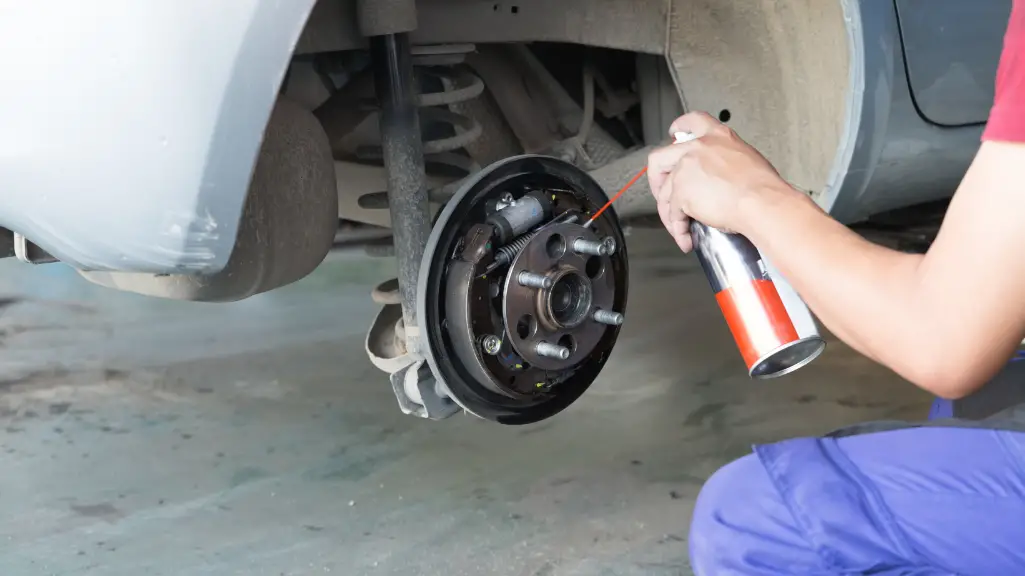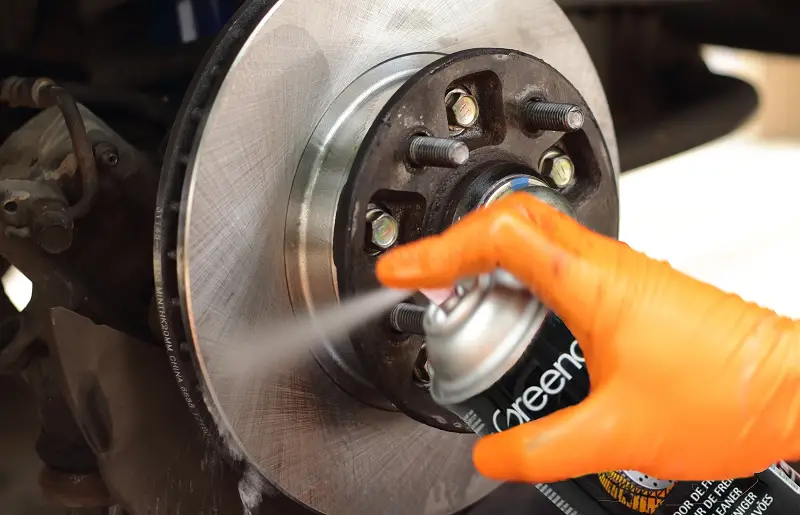To use brake cleaner, spray it onto brake parts like rotors and pads, holding the can about 6-8 inches away. Wipe off excess cleaner, then reassemble the parts and test the brakes.
Brake cleaner is an essential product for anyone who works on vehicles, whether you’re a mechanic or a DIY enthusiast. This powerful solvent is designed to remove contaminants such as oil, grease, dirt, and brake dust from brake parts.
In this blog post, we will cover everything you need to know about brake cleaner—why it’s important, the different types, how to use it properly, and tips for safe usage.

Contents
What Is Brake Cleaner?
Brake cleaner is a fast-drying solvent used to clean brake components such as rotors, pads, drums, and calipers. It removes dirt, grease, and brake dust from these parts, improving performance and extending their lifespan. Brake cleaner comes in several formulations, each designed for specific tasks, but its primary purpose is to ensure brakes operate smoothly and safely.
Types of Brake Cleaners
Before diving into how to use brake cleaner, let’s understand the different types available in the market:
- Aerosol Brake Cleaner: The most common form of brake cleaner, it comes in a spray can. It’s easy to apply and ensures even coverage of brake parts. Aerosol brake cleaners are often used for cleaning parts while they are still on the vehicle.
- Non-Chlorinated Brake Cleaner: A safer option for the environment and your health, non-chlorinated brake cleaners are free from harmful chemicals like methylene chloride. It’s often used for general cleaning and is considered safer for use on rubber and plastic parts.
- Chlorinated Brake Cleaner: Chlorinated brake cleaners contain chemicals like trichloroethylene and perchloroethylene. While effective at cleaning, these chemicals are highly toxic and require extra care in handling. Chlorinated cleaners are often preferred for heavy-duty applications due to their superior cleaning power. Read more about Chlorinated vs Non-Chlorinated Brake Cleaner.
- Heavy-Duty Brake Cleaner: This type is designed for more intensive cleaning jobs. It’s stronger and can remove even the toughest grease and grime. While it may be overkill for lighter tasks, it’s invaluable for vehicles with more extensive buildup.
- Eco-Friendly Brake Cleaner: For those who want an environmentally conscious option, eco-friendly brake cleaners are made with biodegradable ingredients and are free from harmful chemicals. While they may not be as potent as their chlorinated counterparts, they provide a safer alternative for regular maintenance.
Why Use Brake Cleaner?
When you perform brake maintenance, such as replacing brake pads or rotors, you need to ensure that no grease, oil, or contaminants are left on the components. Brake cleaner plays a vital role in:
- Improving Brake Performance: Dirt, grease, and oil on the brake pads or rotors can affect braking efficiency. Contaminants on the brake surfaces reduce friction, leading to longer stopping distances and potentially dangerous situations. Cleaning these surfaces ensures optimal performance.
- Extending Brake Component Lifespan: Contaminants can cause accelerated wear on brake components. For example, oil can break down brake pad material faster, while dirt can cause uneven wear. Brake cleaner helps remove these factors, which can prolong the life of your brakes.
- Enhancing Safety: If you neglect to clean brake components, it could lead to brake failure. A build-up of dust or debris can also result in squeaking or grinding noises. Regular cleaning helps maintain safety by ensuring your brakes work smoothly.
How to Use Brake Cleaner: Step-by-Step Guide
Whether you’re cleaning your car’s brake parts or performing maintenance on a motorcycle, the following steps will guide you through the process.
Step 1: Gather Your Supplies
Before you begin cleaning, make sure you have all the necessary supplies:
- Brake cleaner (aerosol or liquid form)
- Safety gloves and goggles
- Rags or towels
- A jack and jack stands (if you’re cleaning brakes on a car)
- A wrench set (for removing components, if necessary)
- A plastic or cardboard surface to catch any excess cleaner
Step 2: Elevate the Vehicle (If Applicable)
If you’re cleaning the brakes of a car, the first step is to elevate it using a jack and jack stands. Be sure the car is on a flat, level surface before doing this. If you’re working on a motorcycle or bicycle, you may not need to elevate it.
Step 3: Remove the Brake Components (Optional)
While it’s possible to clean brake parts without removing them from the vehicle, you’ll get a more thorough clean if you can take them off. If you choose to do this, use your wrench set to remove the brake calipers, pads, and rotors.
Step 4: Apply Brake Cleaner
Hold the brake cleaner about 6 to 8 inches away from the surface and spray directly onto the brake parts. Use a sweeping motion to ensure even coverage. If you’re using aerosol brake cleaner, be mindful of where the spray lands, as it could affect surrounding surfaces.
For heavy-duty cleaning, apply a generous amount of cleaner and allow it to sit for a few seconds. This helps break down grease and grime. For lighter cleaning, a quick spray will suffice.
Step 5: Wipe Off Excess Cleaner
After spraying the brake parts, use a rag or towel to wipe off excess cleaner and dirt. In some cases, the brake cleaner will evaporate quickly, leaving the parts dry and clean. If needed, you can repeat the application until all contaminants are gone.
Step 6: Inspect the Components
Before reassembling the brake parts, inspect them to ensure they are clean and free from contaminants. Make sure there’s no residue left on the surface.
Step 7: Reassemble and Test
Once the brake components are dry, reassemble them in their proper positions. Once everything is secured, test your brakes before driving to ensure they are functioning properly.

Safety Tips for Using Brake Cleaner
Brake cleaner is a powerful solvent, so it’s crucial to take precautions:
- Work in a Well-Ventilated Area
Many brake cleaners contain fumes that can be harmful if inhaled. Always use brake cleaner in a well-ventilated area, preferably outdoors, or in a garage with the door open. - Wear Protective Gear
Always wear safety gloves and goggles when using brake cleaner. The solvent can irritate your skin and eyes, and you don’t want to take any chances with chemicals. - Avoid Breathing in the Fumes
Never spray brake cleaner directly into your face, and avoid inhaling the vapors. If you’re using chlorinated brake cleaner, take extra care as it contains toxic substances. - Dispose of Waste Properly
Do not dispose of brake cleaner down the drain or in regular trash. It contains hazardous chemicals that need to be disposed of according to local regulations.
Frequently Asked Questions
Here are some FAQs about how to use brake cleaner –
1. Can I use brake cleaner on other parts of my car?
Yes, brake cleaner can be used to clean other parts like the engine, wheels, and transmissions. However, always check the manufacturer’s instructions to ensure the cleaner is safe for the material you’re cleaning.
2. Is brake cleaner safe for all types of brake systems?
Brake cleaner is safe for most brake systems, including disc and drum brakes. However, it’s essential to avoid using it on parts made of plastic or rubber unless the product is labeled as safe for those materials.
3. Can I use brake cleaner on my car’s brake pads?
Yes, brake cleaner can be used on brake pads to remove dust, grease, or contaminants. However, ensure that the pads are dry and free of residue before reassembling them.
4. Is brake cleaner flammable?
Yes, brake cleaner is flammable. Keep it away from heat sources, open flames, or sparks when using it.
5. How often should I use brake cleaner?
Brake cleaner should be used whenever you perform brake maintenance, such as replacing pads, rotors, or when you notice excessive dirt or grime buildup on brake components.
Conclusion
Brake cleaner is a vital tool for maintaining your vehicle’s braking system. By identifying the different types of cleaners available and following proper safety measures, you can ensure that your brakes perform at their best.